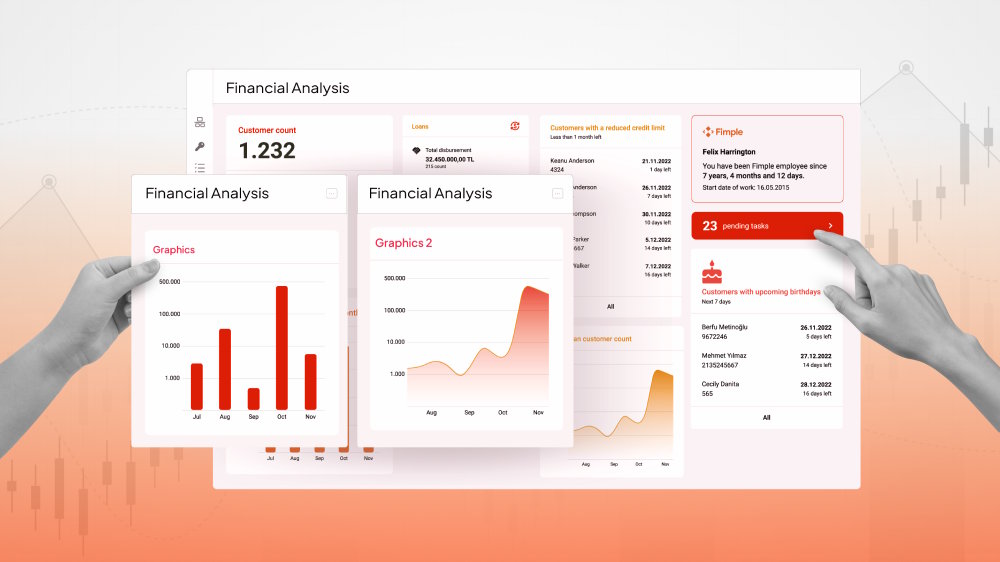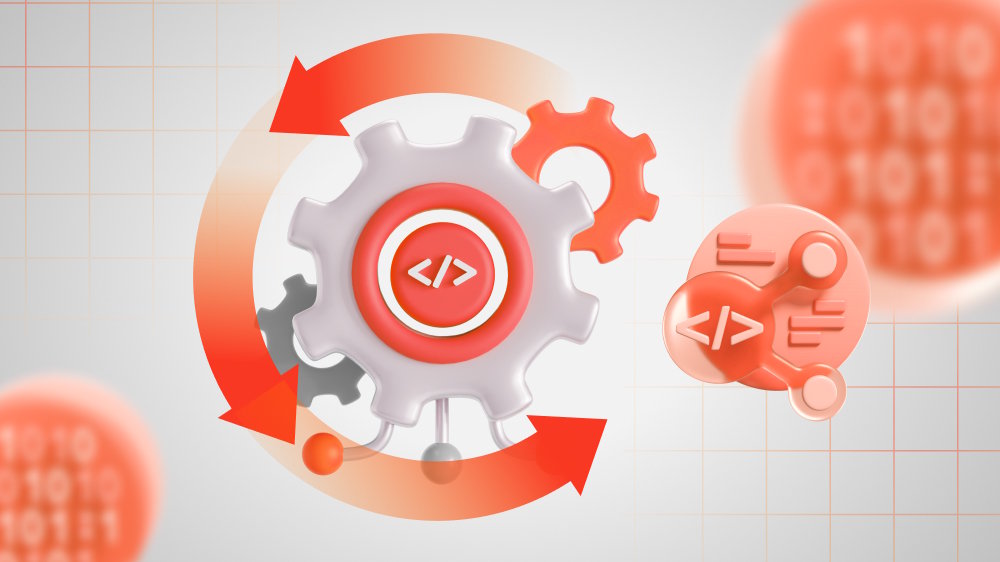
How Much Does Software Development Cost?
Investing in brand-new software or modifying an existing one is a significant expense for any business, and the process can be overwhelming with so many factors to consider. What are they, actually?

Content Map
More chaptersIt is undeniable that off-the-shelf software development products are convenient and effective solutions for basic needs. However, with the recognition of the emphasis on user-centric, existing software, which is designed to be applicable to a broad range of businesses or industries, is gradually no longer suitable in the current context. Embarking on the journey of building custom software solutions now becomes the most optimal choice for creating a competitive advantage and providing greater control to product owners.
However, the fact that up to 45% of software projects exceed budget during deployment leaves businesses with great anxiety. How to build good software with the best balance between price and functionality? You probably ask this question at every software development meeting.
Developing software is a major investment, directly contributing to your business’s bottom line. While labor and infrastructure costs are primary expenses, there are also many hidden costs that organizations might not foresee initially. By evaluating all these factors, businesses can more accurately determine the true custom software development cost. This article may give you some helpful clues about this topic.
Software Development Cost Calculation: How to Calculate the True Costs?
Calculating the cost of software development involves estimating all the resources, time, and expertise needed to deliver a digital product, from planning and design to development, testing, and post-launch support.
The basic formula for software development cost is:
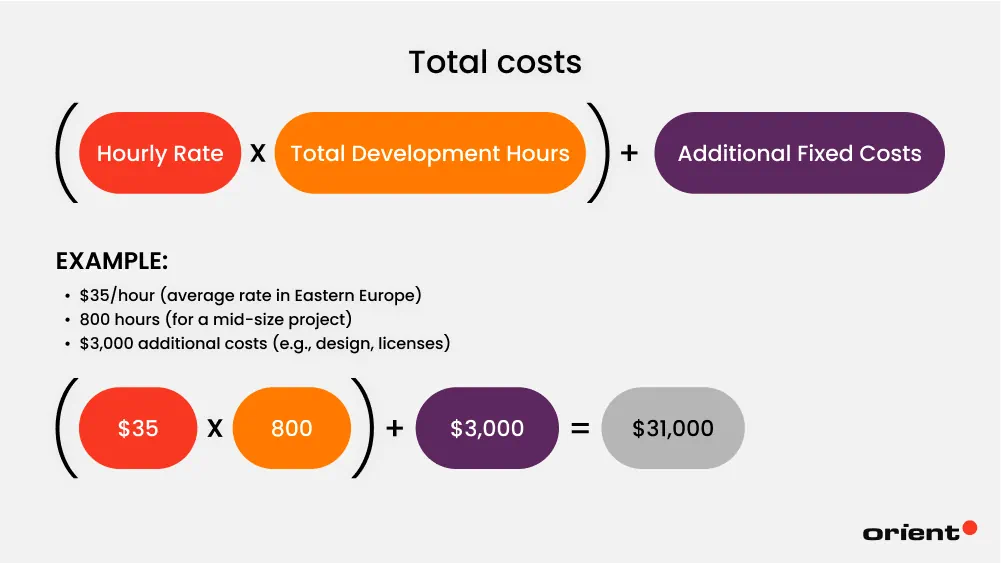
Total Cost = (Hourly Rate × Total Development Hours) + Additional Fixed Costs
Example:
- $35/hour (average rate in Eastern Europe)
- 800 hours (for a mid-size project)
- $3,000 additional costs (e.g., design, licenses)
=> Total Cost = ($35 × 800) + $3,000 = $31,000
However, it is worth noting that the final calculation result is only relative and valid at the current project point. Hidden software development costs and changes in the project scope in future stages will certainly affect the actual cost you have to pay for a complete project.
You can contact a reliable outsourcing vendor and discuss with them your project needs and requirements for more accurate software development cost estimation, even if you haven’t yet committed to partnering with them. Rather than just giving them one price option, they tend to offer a variety of different options for free, based on each of their pricing models. This is where you’ll know whether your target budget aligns with the actual effort required. During the discussion, don’t forget to let them know you’re in the discovery or vendor evaluation stage instead of acting like you’re ready to sign while you’re not.
Key Factors That Affect Your Custom Software Development Costs
Cost factors are exactly the most appropriate answer to the question of how to estimate software development costs. There are several components comprising the overall costs of your software development project. A rough estimate would set you back between $3,000 to $250,000+. The wide difference comes from various factors associated with business requirements and capacity, such as development team, set of features, development time, etc.
Listing out the more cost factors, the more likely you can avoid budgeting issues and calculate the most accurate cost to develop. Check out the software development cost breakdown below to discover all the possibilities.
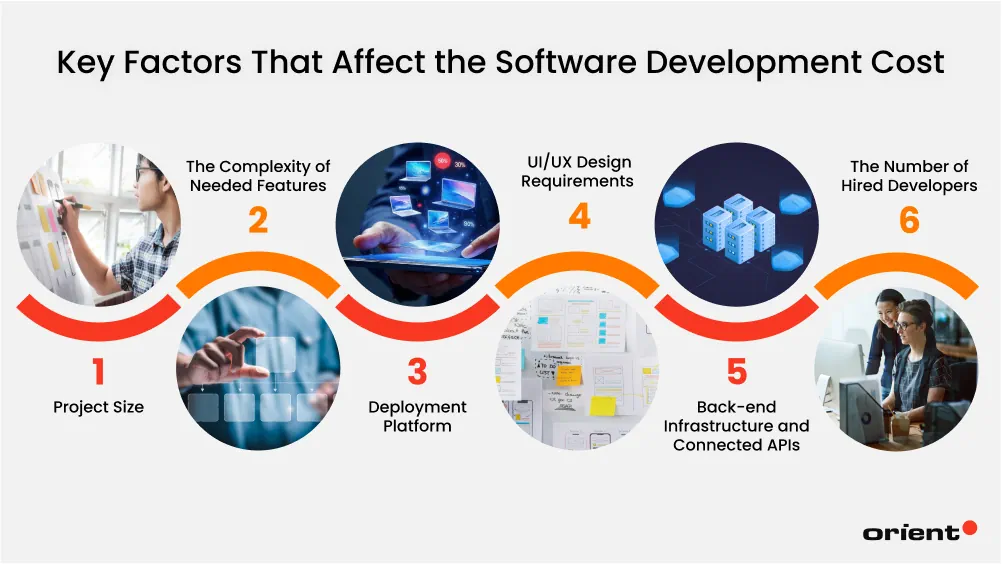
Project Size
Project size refers to the scope and complexity of a particular enterprise’s software. It encompasses multiple factors that clarify the extent of work and the magnitude involved in completing the project. Roughly speaking, the size of a project takes into account the software scope (e.g., the number of features/modules/screens/pages/UI components, data volume) and the user scale, which is the number of end-users it is expected to serve.
There are some common classifications of the project size, including:
- Small Projects: Small projects are software projects that entail carrying out minor modifications with only the essential features. It often involves limited scope, a lower budget, a smaller team of resources, and shorter timelines for completion.
- Medium Projects: This classification covers projects, from a stand-alone solution to multiple system integrations, a database, security, and additional features. Due to increased requirements in all aspects throughout the development process, the pricing allocated for this is generally higher.
- Enterprise Projects: More than just coordination between software development team members, enterprise-level projects require cooperation across stakeholders and departments to align software with business strategy and long-term success. This type often requires investment in third-party integrations, additional software, tools, and infrastructures to ensure smooth operation.
For example, we consider CMS to be a medium-sized project, while CRM can be regarded as a large initiative. Why? CMS allows businesses to simplify the development process by using an off-the-shelf solution like WordPress, but CRM, with its deep focus on user experience, requires many unique customizations to meet the specific needs and operational processes of the customer base, which can potentially lead to higher software development pricing.
The table below offers a brief overview of the software development costs according to the project scope:
| Project Size | Examples | Estimated Cost (global average) |
|---|---|---|
| Small Projects | Landing page | $5,000 – $30,000 |
| Static website | ||
| Basic MVP (Minimal Viable Product) | ||
| Medium Projects | Custom CMS | $30,000 – $100,000+ |
| Booking platform | ||
| SaaS dashboard | ||
| Enterprise-Level Projects | Enterprise Resource Planning Systems (ERP) | $100,000 – $500,000+ |
| Marketplace | ||
| Multi-role app | ||
| Supply Chain Management Solution (SCM) |
As for some other types of software development, such as Customer Relationship Management System (CRM) or eCommerce platforms, they are classified into a separate group of medium to large projects with a wide price range, ranging from $30,000 - $250,000+.
The Complexity of Needed Features
The choice of necessary features and functionalities appearing on a custom application plays an important role in deciding the software development price. The more complex or extensive the needed features are, the higher the cost is likely to be.
However, note that this is not entirely true in all cases. It is possible for a software product with only one complex feature to require a larger investment than a product with several simple features. The feature’s complexity is the critical element that goes beyond its simplicity or number when considering development costs. For instance, a single complex feature like AI-driven matching can demand more time, resources, and specialized knowledge than five common features combined, which deeply impacts the final software project cost.
Real-time features (chat, sync), AI/ML components, security and compliance layers, role-based permissions, etc., are some of the examples of complex features leading to more intense workload, more needed developers, and of course, a larger investment.
See the table below for a cost and time breakdown of some common features.
| Feature Complexity | Example Features | Estimated Cost Range |
|---|---|---|
| Simple Features | User registration/Login | $1,000 - $5,000 |
| Static informational pages | $500 - $3,000 | |
| Basic search functionality | $1,000 - $3,000 | |
| Basic analytics dashboard | $2,000 - $5,000 | |
| Contact form | $500 - $2,000 | |
| Complex Features | Real-time chat with notifications | $10,000 - $25,000 |
| AI-powered recommendation engine | $20,000 - $50,000+ | |
| Blockchain-based transaction system | $40,000 - $100,000+ | |
| Advanced data visualization dashboards | $15,000 - $40,000 | |
| Integration with multiple third-party APIs | $10,000 - $30,000 |
Deployment Platform
The deployment platform you choose (where and how your software will be hosted and run) has a direct impact on the costs of software development. This is because different platforms require different infrastructure setups, development approaches, maintenance strategies, and often different security or compliance efforts.
Which platform do you want your app to work on? iOS, Android, or the web? If you’re starting web application development on platforms like Windows, macOS, or Linux, there is nothing to worry about. However, things are different when building applications for mobile devices. With two operating systems available, including iOS and Android, mobile app development may require two separate codebases (if not using cross-platform tech like Flutter), effectively doubling parts of the effort.
| App Complexity | Native Development | Cross-Platform Development |
|---|---|---|
| Simple App | $25,000 - $50,000 | $20,000 - $40,000 |
| Moderate App | $50,000 - $150,000 | $40,000 - $90,000 |
| Complex App | $150,000 - $300,000+ | $90,000 - $150,000+ |
| Enterprise-Level | $200,000 - $500,000+ | $120,000 - $200,000+ |
UI/UX Design Requirements
Creating custom software with a clear UI/UX is critical in retaining a loyal user base. However, such a process is more expensive than you think. The more complex the design, the more it costs. The complexity here is not necessarily how you perceive the interface of a website or any application but also what goes on inside it, which only insiders can know, such as user flow and logic, design depth, research, testing, etc. That is why, while many designs may look simple, they eventually add up to the cost of software development.
To analyze the complexity of a UI/UX design, there are various elements that need to be taken into consideration which they are:
- Design Depth and Customization: Simple designs using ready-made templates cost less than time-consuming custom or branded animated UI/UX. For example, a landing page using a theme might cost $500–$1,500, while a fully custom, animated homepage can cost up to $5,000+.
- Number of Screens/User Flows: The more unique screens or interaction flows (e.g., onboarding, checkout, dashboards), the more design work is required. The cost range is between $2,000 - $5,000 for 5-10 screens and $10,000 - $30,000+ for 20+ screens (with variations).
- Prototyping and Wireframing: While low-fidelity wireframes (basic layouts) are fast and inexpensive, high-fidelity clickable prototypes (realistic, interactive mockups) require more time, tools (e.g., Figma, Adobe XD), and collaboration, which increase costs.
- UX Research and Testing: If your project includes user interviews, A/B testing, or usability testing with real users, the overall cost might include higher upfront design expenses. The typical cost for such UX research cycles is around $5,000–$15,000+.
- Animations, Microinteractions, and Accessibility: Certain design elements like custom illustrations or micro-animations enhance your application’s visual appeal, but they also require extra work and may increase dev/design time by 15–30%, depending on scope.
In a nutshell, the estimated UI/UX design cost ranges follow the table below:
| Design Scope | Estimated Cost (USD) | What It Includes |
|---|---|---|
| Basic Design | $1,000 - $3,000 | - Uses pre-built UI kits or templates (e.g., Bootstrap, Tailwind UI) - Minimal branding or customization - Limited screens (up to 5) - No animations or UX research |
| Mid-Level Custom Design | $4,000 - $10,000 | - Custom branding, layout, and color schemes - About 10-15 unique screens - Interactive elements (forms, modals, basic feedback) - Mobile responsiveness |
| High-End UI/UX Design | $15,000 - $40,000+ | - About 20+ highly customized screens - Interactive prototypes + design systems - Advanced microinteractions, animations, motion graphics - Accessibility (WCAG) compliance - In-depth UX research |
Back-end Infrastructure and Connected APIs
The back-end infrastructure handles many background processes that enable the app to function smoothly. This explains why backend and APIs often represent 40-60% of total software cost, especially for data-driven, scalable, or user-heavy systems. If your application requires features like user authentication, role-based access, data analytics, or real-time updates (e.g., live chat or notifications), you will need a more sophisticated and costly backend setup compared to a simple backend with basic login and CRUD operation.
Most applications nowadays require some form of integration with third-party services like Stripe for payments, Google Maps for location, or Twilio for messaging. Each integration typically costs from $1,000 to $5,000, depending on two core factors: API complexity and the level of customization needed. If you are using outdated legacy systems or custom ERPs, the cost can even double due to time spent troubleshooting and adapting.
| Component | Estimated Cost (USD) |
|---|---|
| Basic Backend (CRUD + Auth) | $5,000 - $15,000 |
| Advanced Backend (roles, workflows, analytics) | $20,000 - $60,000+ |
| API Integrations (per API) | $1,000 - $5,000+ |
| Real-Time Capabilities | $10,000 - $30,000+ |
| Infrastructure Setup (DevOps) | $5,000 - $25,000+ |
The Number of Hired Developers
Depending on the project’s scope, a development team can have three to twelve or more people. The more developers are involved, the faster the project will be completed. However, the number of people hired will obviously have a profound effect on the average cost of your software development.
Basically, a well-form developer team often consists of four key roles, including a project manager, developers, a QA tester, and a UI/UX designer. Medium to large projects need additional roles, such as business analysts and database engineers.
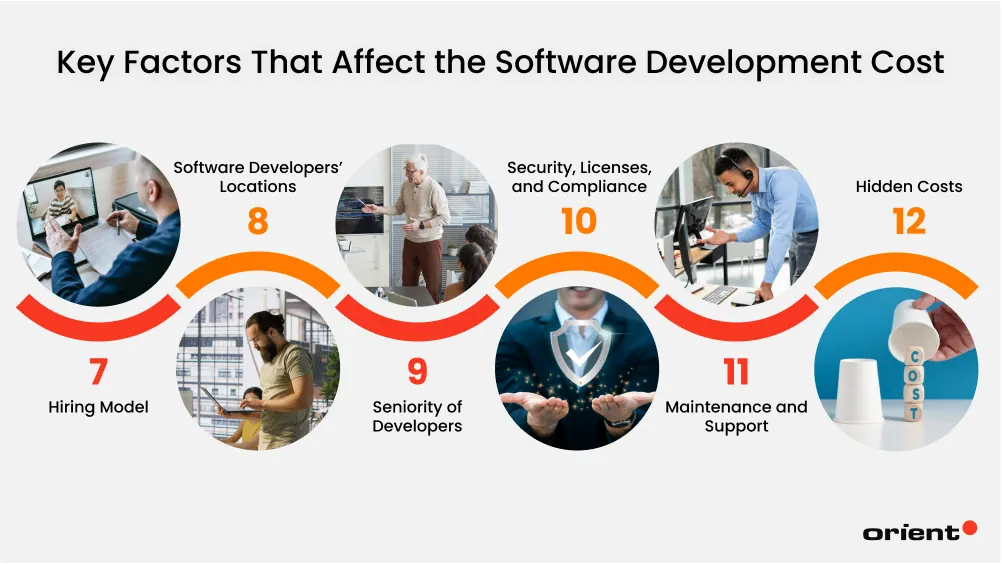
Hiring Model
How do you want to work with the developers? Do you want their exclusive expertise or just their service on a less intensive scale? There are three hiring models, including in-house, freelancing, and outsourcing.
An in-house team can guarantee the highest service quality but also demand the most time and money to hire, train, and invest in resources. On the opposite side of the scale is the concept of freelancing, which is the most affordable option, but the quality of work may suffer due to a lack of motivation, unreliability, and poor communication.
Outsourcing your project to a dedicated team provides the best of both worlds. It costs less than building an in-house team from scratch while allowing access to quality-assured developers.
The table below may give you some clues about each hiring model:
| Hiring Model | Cost | Best for |
|---|---|---|
| In-House | High (long-term) | Full control, long-term projects |
| Freelancers | Low to medium | Small tasks, MVPs, short timelines |
| Outsourcing | Medium | Fast delivery, full-stack needs |
Software Developers’ Locations
If you choose to use software development services from outsourcing companies or hire freelancers, note that their developer location also has a strong influence on the overall project cost. Based on average personal income and standard of living, developers based in the USA and Western Europe charge much higher hourly rates than those from other places. That is the reason why today’s customers often prefer talent pools from Asian countries the most. Vietnam, for example, with various notable benefits, is a popular destination for organizations wishing to save money while still ensuring project outcomes.
Here is a table of the average annual salary worldwide:
| Region | Example Countries | Average Annual Salary (USD) |
|---|---|---|
| Europe | United Kingdom (UK) | $67,000 |
| Poland | $45,000 | |
| Ukraine | $48,000 | |
| Sweden | $56,000 | |
| Netherlands | $77,000 | |
| Switzerland | $120,000 | |
| Americas | United States (US) | $144,000 |
| Canada | $80,000 | |
| Argentina | $15,000 | |
| Mexico | $22,000 | |
| Venezuela | $5,500 | |
| Asia | China | $57,000 |
| Japan | $52,000 | |
| Vietnam | $17,000 | |
| India | $11,000 | |
| Israel | $70,000 |
It would help if you also considered time zones, cultural differences, and language barriers that can influence how you communicate with the outsourcing team, which may ultimately affect the total development time.
Seniority of Developers
Choosing employees with whatever level of experience depends mainly on the vacancy requirements and the company’s budget. While a senior developer may cost twice as much, they get things done 3x faster, with fewer bugs and better long-term results. On the other hand, junior developers save money up front but may require more time, more oversight, and lead to more rework or technical debt.
Sometimes, a small team of seniors can outperform a larger team of juniors in both cost and quality. As every hire has its own price and distinct characteristics, it is our advice to carefully consider your project’s financial limits to choose the right piece.
Software developer’s hourly rate based on seniority is as follows:
| Developer Level | Avg Hourly Rate (Global Range) | Monthly Cost Estimate |
|---|---|---|
| Junior Developer | $20 - $40/hour | $2,500 - $6,000 |
| Mid-Level Developer | $40 - $80/hour | $6,000 - $10,000 |
| Senior Developer | $80 - $150+/hour | $10,000 - $20,000+ |
Security, Licenses, and Compliance
Issues surrounding security, such as licensing agreements and regulatory compliance, are some of the most important software development cost factors that may cause businesses many unexpected hidden expenses. Security is always the top concern for businesses developing software applications, including banking apps. Investing in encryption techniques, secure coding practices, and regular security audits to limit cyber security risks and vulnerabilities obviously leads to higher development costs.
Depending on the project’s requirements, some software requires developers to acquire licenses for third-party libraries, frameworks, or tools that are used in the development process. Failure to comply with licensing agreements or other security incidents, like data breaches, could lead to legal consequences and potentially costly penalties related to certain regulations and standards, such as DPA or HIPAA.
Maintenance and Support
After the initial development phase, ongoing maintenance and upkeep costs can arise to ensure the software’s smooth operation, stability, and longevity. This process not only mandates dedicated resources, including tools and infrastructure, but also requires additional specialized personnel.
These resources come at a cost, whether it involves hiring in-house staff or outsourcing IT support services. The cost used for maintenance and support can vary depending on the complexity of the system, the size of the user base, and the level of support required. As the software product evolves and matures, this cost type can also grow accordingly to maintain performance and user satisfaction.
Hidden Costs
The real cost of software is not just about coding. Rather, it is everything needed to make a software product usable, stable, secure, and maintainable. In addition to the costs listed above, there are also some hidden costs that you may not see or predict at the beginning. Hidden costs are most obvious and affect your final software development cost when your project is being implemented. That is why, instead of calculating the exact cost, businesses usually add a margin to cover unexpected cases.
Here’s a breakdown of the most common hidden costs you should account for:
| Hidden Costs | Components | Cost Impact |
|---|---|---|
| Project Management | - Time to manage scope, approve designs, and provide feedback - Meetings, alignment sessions, and status updates | Add 10-15% to vendor costs if they handle it |
| Scope Creep & Feature Changes | - Design and development revisions - New testing cycles - Timeline extensions | Cost hundreds to thousands of dollars to change the original scope |
| Documentation & Training | - Project documentation - User training | Hire a technical writer or trainer may cost around $1,000 - $5,000+ |
| Testing Time | - QA testing - Automated test scripts - Cross-device / cross-browser testing | Add 10-20% to your development cost |
| Communication and Collaboration Tools | - Licensing and subscription fees - Learning curve - Access control - Workflow bottlenecks | Add $300 - $800 per month |
Tips to Minimize the Cost of Software Development
The budget for your software can be reduced even further if you know how to apply some simple tips throughout the development process. Maximize your software development cost estimation while still delivering a high-quality product that meets business objectives and user needs with these solutions.
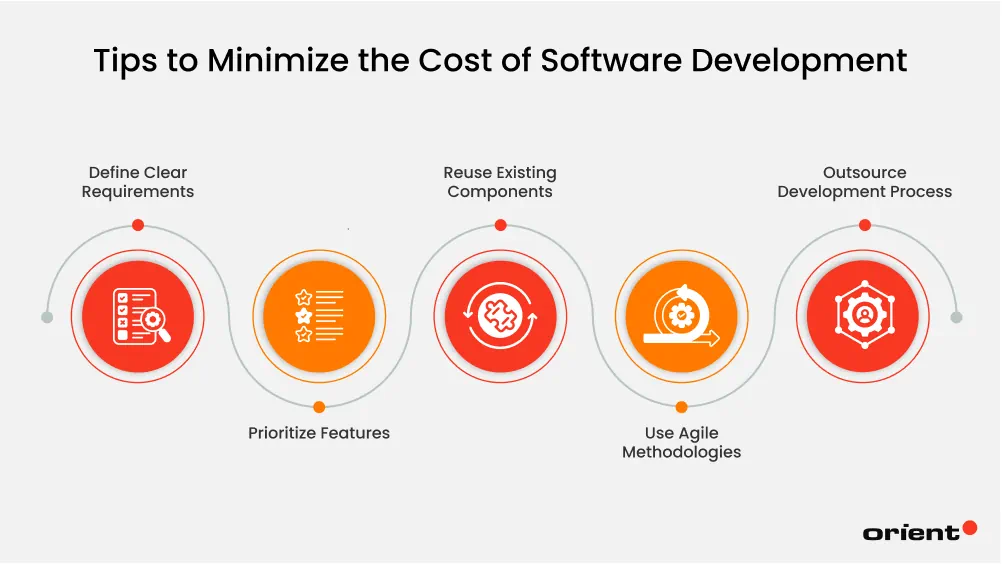
- Define Clear Requirements: Clearly defining and documenting the project requirements upfront helps businesses avoid scope creep and reduce the need for costly changes during development.
- Prioritize Features: Develop needed features in priority order, starting from core functionality and then moving to additional features in later iterations or updates to reduce all-at-once cost.
- Reuse Existing Components: Instead of building everything from scratch, take advantage of existing frameworks, libraries, and open-source components, as this is an effective way to save time and budget.
- Use Agile Methodologies: Adopt Agile development methodologies such as Scrum or Kanban, which allows businesses to develop incrementally and collaborate, providing flexibility to adjust project requirements and resources as needed.
- Outsource Development Process: With a large talent pool available from many different countries, using a software development company is a popular choice for customers who want to cut recruitment, training, and benefits costs.
Summary
Investing in brand-new software or modifying an existing one is a significant expense for any business, and the process can be overwhelming with so many factors to consider. It is wise to start this process with the discovery phase to lay out a clear set of goals and scope for your software. Scoping and setting goals enable you to know clearly what your software needs so that you can give the development team succinct instructions based on your requirements.
Ultimately, the total price comes down to the number of people, hours, and the complexity of the technology involved. Contact Orient Software and use our extensive expertise and affordable pricing to create a custom solution with the best balance between quality and cost.


